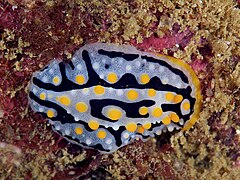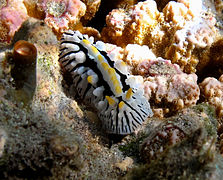
Aplysiidae is the only family in the superfamily Aplysioidea, within the clade Anaspidea. These animals are commonly called sea hares because, unlike most sea slugs, they are often quite large, and when they are underwater, their rounded body shape and the long rhinophores on their heads mean that their overall shape resembles that of a sitting rabbit or hare. Sea hares are however sea snails with shells reduced to a small plate hidden between the parapodia, and some species are extremely large. The Californian black sea hare, Aplysia vaccaria is arguably the largest living gastropod species, and is certainly the largest living heterobranch gastropod.

Aplysia is a genus of medium-sized to extremely large sea slugs, specifically sea hares, which are one clade of large sea slugs, marine gastropod mollusks.

The Polyceridae are a taxonomic family of sea slugs, dorid nudibranchs, marine gastropod mollusks within the superfamily Polyceroidea.

Elysia is a genus of sea slugs, marine gastropod molluscs in the family Plakobranchidae. These animals are colorful sea slugs, and they can superficially resemble nudibranchs, but are not very closely related to them. Instead they are sacoglossans, commonly known as sap-sucking slugs.
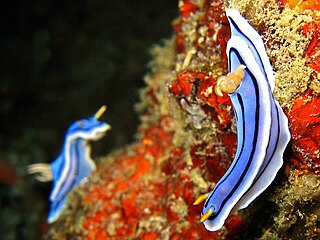
Chromodoris is a genus of very colourful sea slugs or dorid nudibranchs, marine gastropod molluscs, and the type genus of in the family Chromodorididae. Within the genus Chromodoris, there are currently 101 classified species. Species within Chromodoris are commonly found in tropical and subtropical waters, living as members of reef communities and preying primarily on sponges. A molecular phylogeny of the family Chromodorididae resulted in this genus being restricted to a smaller number of species than formerly, most of which have longitudinal black lines on the mantle. Many former members of Chromodoris were transferred to Goniobranchus
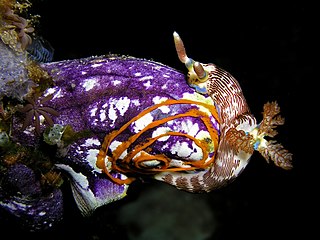
Nembrotha is a genus of sea slugs, nudibranchs, marine gastropod molluscs in the family Polyceridae.
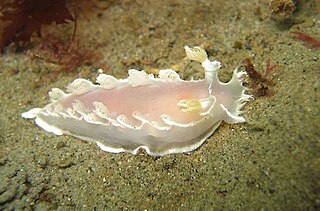
Tritonia is a genus of sea slugs, nudibranchs, shell-less marine gastropod molluscs in the family Tritoniidae.
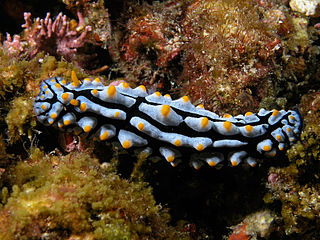
Phyllidiidae is a family of sea slugs, dorid nudibranchs, marine gastropod mollusks in the superfamily Phyllidioidea.
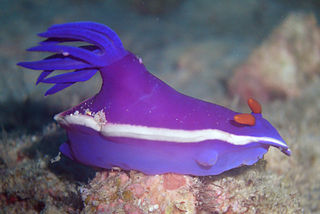
Hypselodoris is a genus of colourful sea slugs or dorid nudibranchs, marine gastropod mollusks in the family Chromodorididae. Modern usage follows a more restricted view of which species belong in this genus so there are numerous genus transfers.

Glossodoris is a genus of sea slugs, dorid nudibranchs, shell-less marine gastropod mollusks in the family Chromodorididae.
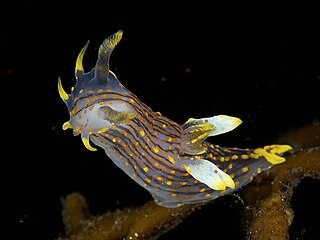
Polycera is a genus of sea slugs, specifically nudibranchs, shell-less marine gastropod molluscs in the family Polyceridae.
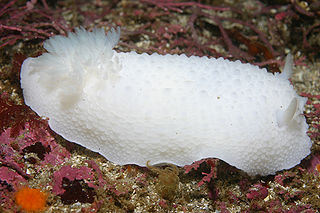
Doris is a genus of sea slugs, specifically dorid nudibranchs. These animals are marine gastropod molluscs in the family Dorididae.
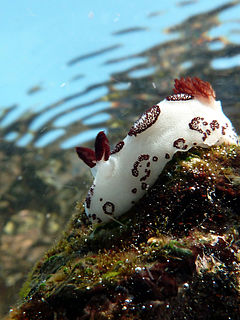
Jorunna is a genus of sea slugs, dorid nudibranchs, shell-less marine gastropod molluscs in the family Discodorididae.

Dendrodoris is a genus of nudibranchs, marine gastropod molluscs in the family Dendrodorididae.

Platydoris is a genus of sea slugs, dorid nudibranchs, shell-less marine gastropod mollusks in the family Discodorididae. These nudibranchs are large and often brightly coloured, but normally live concealed beneath rocks or loose coral, feeding on sponges. During the night they become more active, searching for new food sources or mates. Many species were described in the 19th century and a revision in 2002 added six new species.
Fryeria is a genus of sea slugs, dorid nudibranchs, shell-less marine gastropod molluscs in the family Phyllidiidae.

Phyllidiella is a genus of sea slugs, dorid nudibranchs, shell-less marine gastropod molluscs in the family Phyllidiidae.

Phyllidiopsis is a genus of sea slugs, dorid nudibranchs, shell-less marine gastropod molluscs and is the largest genus within the family Phyllidiidae.

Goniobranchus is a genus of sea slugs, dorid nudibranchs, shell-less marine gastropod molluscs in the family Chromodorididae.






